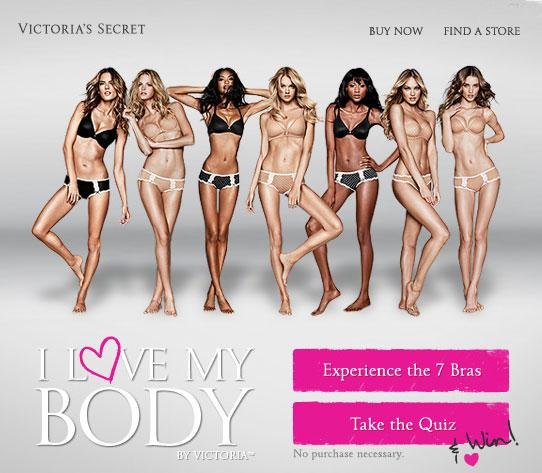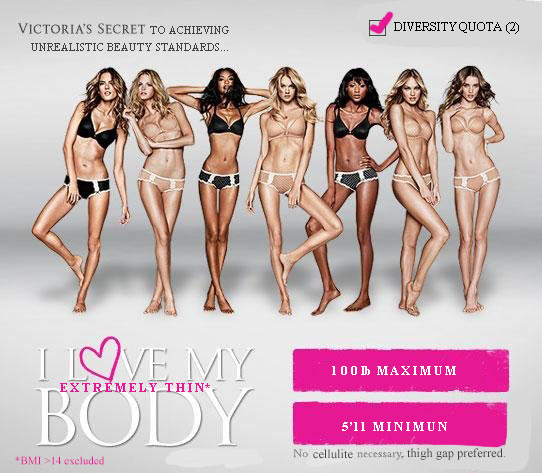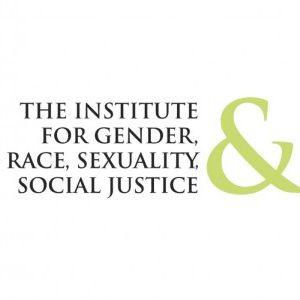
Original Victoria’s Secret Advertisement
Victoria’s Secret to Unrealistic Beauty Standards:
In 2010, Victoria’s Secret released a Spring/Summer Ad campaign called I Love my Body. Displayed in the print advertisement are seven women, all with very similar body types. Each woman is very thin, tall and have almost identical weight distributions. The ad has the potential to be harmful as it sets unrealistic body standards in order to qualify to love one’s body.
Arguably, the standards displayed in the ad are unachievable. With so many different possible body types, the majority of women and people viewing this ad would feel excluded from the very limited representation. Many bodies will be physically unable to ever look exactly the way the models displayed in the ad appear for a variety of reasons including bone structure, family history, metabolism, or different people’s individual requirements for a healthy diet. Additionally, the women in the advertisement likely do not even look exactly the way they do in the ad. Their bodies are undoubtedly photoshopped and edited in order to produce a hegemonic idea of the ‘perfect body’ worthy of ‘love’.
As noted, this strict depiction of beauty and worth can produce very harmful consequences. For example, “feminist researchers have widely documented the pressures on women to maintain an ‘ideal’ body shape and the implications of this for women more generally, which may or may not include serious eating disorders but do include weight preoccupation, body image dissatisfaction, and low self-esteem…women have a higher rate of diagnosed eating disorders than men” (Morrow & Hankivsky, 112). As such, these advertisements can have real-life consequences which disproportionately impact women and must be taken seriously.
On the surface, the ad claims to promote self-love but the unrealistic beauty standards presented are grounded in Eurocentric ideals that celebrate thinness and whiteness. There are two women of colour present in the advertisement, although given the severe lack of diversity in all other aspects of the chosen models, it feels like the inclusion of two black women was a decision based in tokenism or to fill a quota, rather than a genuine effort to present a range of body types or to appeal to a broader audience. Such a narrow representation of those worthy of self-love has harmful consequences; it implies that only one specific type of body is desirable, and that anyone who doesn’t look like the models that appear in the ad shouldn’t love their body as they are not ‘attractive’ or ‘good enough’.

Jammed Version of the Victoria’s Secret Advertisement
Jammed Version:
In my jammed version of the 2010 Victoria’s Secret I Love my Body campaign, I attempt to subvert the advertisement in order to highlight the harmful reality of its absurd standards. I made the implicit messages explicit by altering the slogans, company name and other text references in the advertisement. Specifically, I adjusted the company name to appear as “Victoria’s Secret to Achieving Unrealistic Beauty Standards”. I chose to alter the company name to draw attention to the fact that this is not an isolated incident for Victoria’s Secret, as many of their advertisements exclusively include models with similar, very thin body types.
I made some changes to the slogans within the advertisement, including adding “extremely thin” to describe the body types to which the ad is promoting love. It is important to emphasize that I am not critiquing or shaming thin bodies, but instead I am highlighting the exclusion of other shapes and sizes. To further emphasize this implicit exclusion within the ad, I added an explicit message in the bottom left corner stating that anyone with a Body Mass Index (BMI) above 14 was excluded. Additionally, I included other ‘restrictions’ within the advertisement such as a 100 lb maximum weight and a 5’11 minimum height requirement to emphasize the unachievable standards Victoria’s Secret has chosen to display. Strategically placed fine print also discourages cellulite and encourages thigh gaps. I included all of these very limiting ‘restrictions’ to highlight the extremely narrow category of women that have the potential to feel represented by the ad’s harmful depictions of what type of bodies are ‘lovable’.
Lastly, I included a check box in the top right corner indicating the attainment of a diversity quota in order to highlight that diversity is so much more than tokenism and should be applied to various factors. In addition to race, the ad would need to depict a wide range of body shapes, sizes and abilities to promote love towards the many different, realistic body types. Sadly, by only including a narrow range of body types, the company promotes that only a select group of women can be considered “lovable” or “perfect”.
Sources:
I Love my Body Ad Campaign. (2010). Retrieved from https://www.instyle.com/news/victorias-secret-launches-i-love-my-body-campaign
Morrow, M. & Hankivsky, H. 2007. Feminist methodologies and health research: Bridging trends and debates. M. Morrow, O. Hankivsky & C. Varcoe (eds.), Women’s Health in Canada: Critical Perspectives on Theory and Policy (pp. 93-123). Toronto: University of Toronto Press.
